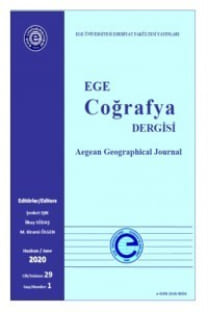TÜRKİYE REKOR MAKSİMUM VE MİNİMUM HAVA SICAKLIKLARININ FREKANSLARINDA 1950-2014 DÖNEMİNDE GÖZLENEN DEĞİŞMELER VE ATMOSFER KOŞULLARIYLA BAĞLANTILARI
Çalışmada 1950-2014 döneminde Türkiye’deki 81 meteoroloji-klimatoloji istasyonunda kaydedilen rekor maksimum ve minimum hava sıcaklıklarının yıllık sayılarındaki zamansal değişimler ile en fazla rekor sıcaklık olayının gözlendiği yıl, mevsim ya da aylardaki yüzey ve üst atmosfer sinoptik klimatolojik/meteorolojik koşulları incelendi. Sonuçlar, Türkiye’de ölçülen rekor minimum hava sıcaklığı frekansının 1950’li yıllardan günümüze doğru azaldığını, rekor maksimum hava sıcaklığı frekansında ise bir artış olduğunu ve bu artışın özellikle 2000’li yıllarla birlikte belirginleştiğini göstermektedir. Rekor maksimum sıcaklık olaylarının yarısı 2000-2014 döneminde kaydedilmiştir. Rekor sıcaklıkların frekansının en yüksek olduğu yıllar sırasıyla, 2010, 2007 ve 2008’dir. Türkiye’de kaydedilen yıllık rekor minimum hava sıcaklığı frekansları ise, 1980’lerin ortasından beri belirgin bir azalma eğilimi göstermektedir. Azalma eğilimi, 2005 yılı sonrası daha da kuvvetlenmiştir. Rekor minimum hava sıcaklıklarının frekansı, sırasıyla 1985, 1967 ve 1950 yıllarında en yüksek sayıya ulaşmıştır. Çalışmada kullanılan 81 istasyonda en yüksek sıcaklık değerleri 2000 yılında, en düşük günlük sıcaklıklar ise 1950 yılında kaydedilmiştir. Rekor yüksek ve düşük hava sıcaklıklarının kaydedildiği yıllarda, sinoptik ölçekli belirgin yüzey ve yüksek atmosfer basınç, rüzgâr ve sıcaklık anomalisi desenleri etkili olmuştur. Rekor maksimum hava sıcaklıklarının frekansının arttığı yıllarda, çoğunlukla kuvvetlenmiş ve uzun dönemli güney sektörlü yüzey ve sınır katmanı rüzgârları ile asıl olarak 850 hPa jeopotansiyel yükseklik düzeyinde gelişen güney sektörlü sıcak hava adveksiyonları gözlenmektedir. Türkiye’de rekor minimum sıcaklıkların frekansının yüksek olduğu yıllarda ise, Orta Akdeniz Havzası, Balkanlar ve Batı Anadolu üzerinde egemen bir antisiklonik anomaliyle bağlantılı kuzey sektörlü rüzgârların yanı sıra, 850 hPa standart basınç düzeyinde Anadolu ve Mezopotamya üzerinde yerleşik zayıflayan meridyonal rüzgârlarla bağlantılı görece soğuk hava akımları egemen olmaktadır.Anahtar Sözcükler: Maksimum ve minimum hava sıcaklıkları; Rekor hava sıcaklıkları; 20. Yüzyıl yeniden analiz verisi; Standart atmosfer basınç düzeyi; Troposfer.
Observed Changes in the Frequencies of Record Maximum and Record Minimum Air Temperatures in Turkey during the period 1950-2014 and their Connections with Atmospheric Conditions
The study investigated both temporal variations of record maximum and minimum air temperatures and the surface and upper atmosphere synoptic climatological and meteorological conditions in years, seasons or months in which the highest number of record temperature events were observed at the 81 climatological-meteorological stations of Turkey during the 1950-2014 period. Results have shown that the frequency of record minimum air temperature events observed in Turkey decreased from the 1950s to the present time, while the frequency of maximum air temperature events increased evidently in particular with the year of 2000. Half of the record maximum air temperature events were recorded in the period of 2000-2014, along with the highest annual frequency in the years 2010, 2007 and 2008, respectively. On the other hand, annual frequency of record minimum air temperature events observed in Turkey has shown an evident decreasing trend since the mid of 1980s. Decreasing trend was most strong after the year 2005. Frequency of the record minimum air temperature events reached the highest figures in the years of 1985, 1967 and 1950, respectively. The highest values of daily maximum temperatures occurred in the year 2000, whereas the lowest values of daily minimum temperatures recorded in the year 1950. Particular anomalous patterns of the synoptic-scale surface and upper atmospheric pressure, wind and air temperatures became effective in the years in which record and record maximum and minimum air temperature events were recorded. During the years of increased frequency in the record maximum air temperatures, mostly increased and long-term southerly (winds from all of south sector) surface and boundary layer winds, particularly the southerly warm air advections developed at the 850 hPa geopotential height level have been observed. On the other hand, northerly winds (winds from all of north sector) associated with an anticyclonic anomaly dominated over the Middle Mediterranean Basin, Balkans and West Anatolia along with relatively cold air flows associated with the weakened meridional winds at the 850 hPa standard pressure level located over the Anatolia and Mesopotamia.Key Words: Maximum and minimum air temperatures; Record air temperatures; 20th Century Reanalysis Data; Standard atmosphere pressure level; Troposphere.
- Yayın Aralığı: Yılda 2 Sayı
- Başlangıç: 1983
- Yayıncı: Prof. Dr. Şevket IŞIK
Sayıdaki Diğer Makaleler
ULUSLARARASI TURİZM ULAŞTIRMASININ AKIŞ YÖNÜ VE DAĞILIŞ DOKUSU
ATMOSFERDE BUZ KRİSTALLERİNİN VARLIĞIYLA İLİŞKİLİ ATMOSFERİK OPTİK OLAYLARI
KAYACIK YERLEŞİMİNİN (GÖRDES-MANİSA) POTANSİYEL DEĞERLERİ ve GELECEĞİ ÜZERİNE DÜŞÜNCELER
PROF. DR. İBRAHİM ATALAY’IN MESLEK YAŞAMI VE TÜRK COĞRAFYASINA KATKILARI
